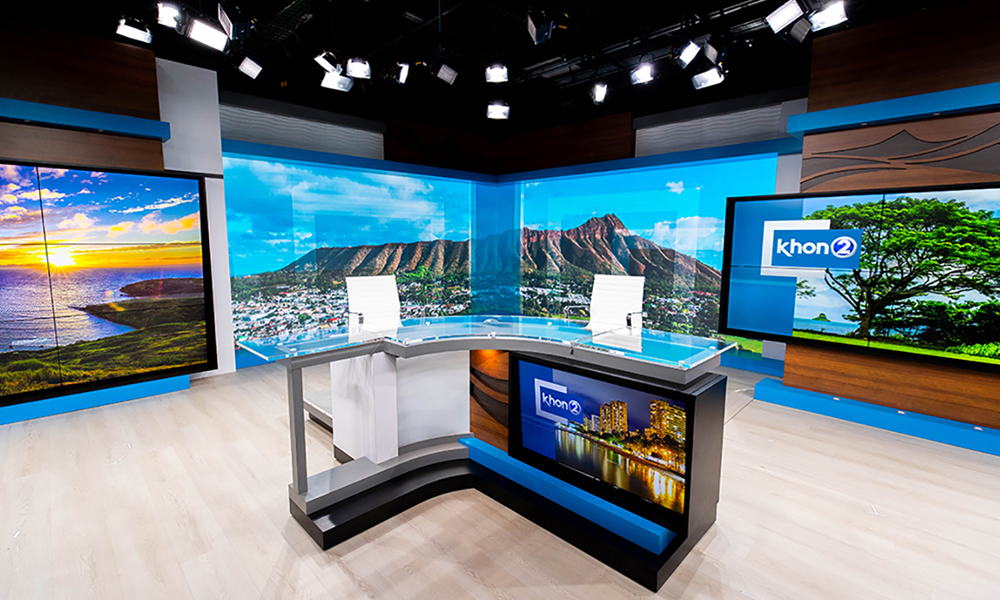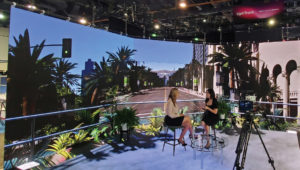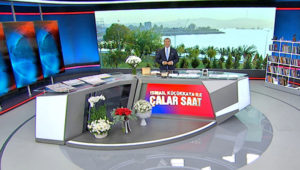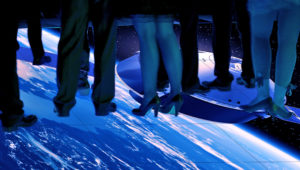
Video Walls, Now Cheaper, Broaden TV’s Studio And Storytelling Prospects

As they become less expensive and higher quality, video walls are playing increasingly larger roles in broadcast sets.
Video walls do more than serve as a set element or assist in storytelling. They make virtual and multi-use sets possible. As more studio set designs feature video walls, whether they are LED or LCD, it’s important that all the content displayed on these walls shines. That’s a bigger task than at first it appears, and different technologies come into play to ensure content looks great today and that broadcasters are futureproofing their video wall choices for tomorrow.
“The price has come down so much over the last five years that set designers and studios are starting to integrate them into their design,” Neoti CTO Aaron Kipfer says.
Video Walls As Design Element
At first, LED walls were being used as a screen replacement, he says, “but as designers started getting more creative, they’re being used for more than backdrops.”
They are being used as scenic pieces, columns and in places where light boxes once were, he says.
“The advantage is that everything becomes a display,” Kipfer says.
Sony’s Rich Ventura, VP of B2B, says the use of curved and rounded video walls is “really opening up set design.” It gives “an artistic look and feel with curves or shapes or angles that you’re not able to do with a traditional LCD display.”
Mack McLaughlin, CEO-creative director at FX Design Group – Giant Octopus, says some stations are using video walls to create an environment, such as a living room or kitchen, and he expects to see more use of video walls for scene setters in addition to their use as storytelling devices.
Chanan Averbuch, Primeview’s EVP Americas, sales & marketing, says over the last five years, “more customers want video walls than ever before.”
In addition to being used to tell stories, they “give the downtown experience” when used as a background, he says.

Planar demonstrated an extended reality stage at NAB 2022, featuring Planar CarbonLight VX Series indoor LED video wall and flooring displays.
Robert Detwiler, director of LED products at Planar, says one of the trends has been the move from LCD backdrops to full immersive LED walls that “can truly fill a camera’s image” and are being used as a design element as well as for content delivery.
While FX has done a number of retrofits that saw LED walls replace LCD displays, LCD is still being used. FX recently installed LCD displays at the KHON Honolulu studio.
Video walls often display graphics to support storytelling.
VR, AR And XR’s Role
Detwiler says he is seeing broadcasters move toward using the walls to incorporate virtual reality (VR) and extended reality (XR) in storytelling.
“The Hollywood market has already adopted it, and the bigger studios are looking at it. Places that can embrace all the technology that has to go with it,” he says.
Averbuch says augmented reality (AR), mixed reality (MR) and VR are being integrated into the studio experience. He called The Weather Channel, which installed a Primeview video wall some years back, a trendsetter in using AR in weather storytelling.
“It’s a dynamic experience,” he says.
McLaughlin says the Weather Channel is “doing VR and AR all day long, and still the local stations say, ‘We can’t do that.’ But you can and you should.”
Averbuch says video walls are being used for ceilings and floors as well, such as sports studios using walkable LED floors that facilitate AR experiences.
Enabling Virtual Sets
Video walls can also enable virtual sets, Kipfer says. Talent can be inside a cube or a two-sided wall that joins together, making the entire background the set, he says.
“The advantage is you can change the set and design as quickly as needed,” he says. “Some studios are converting their entire studios to virtual sets with no other elements, just a giant video wall that they are using in creative ways.”
That’s a trend Ventura has noticed.
Broadcasters typically had huge sets dedicated to individual shows, Ventura says, but he’s seeing a shift toward using video walls to create multiuse, multipurpose sets.
The flexibility gives broadcasters the “ability to do a lot more” with their studios, he adds.
Content Strategy’s Necessity
But choosing a great video wall is only part of the picture, Kipfer says. Broadcasters need to think about the content they put on the video walls.
“It’s great to put a 100-foot LED wall in your studio, but if the content you’re putting on it isn’t taking advantage of the resolution of the wall, it can do more harm than good,” he says. “You can have the best video wall on the planet but if the content doesn’t match that professional look, you miss out on having some of the advantages of using LED in the first place.”
Making sure the video looks great is easier said than done. One reason is that video walls aren’t all standard sizes, which can present a problem when content placed on them isn’t standard resolution or a standard aspect ratio, Kipfer says.

Measuring more than 22 ft. x 8 ft. and with a 5K x 2K resolution, Sony’s Crystal LED direct view display at Fox TV’s news studio in Turkey offers plenty of space to accommodate the expansive presenting style of their anchors, who make full use of the studio during broadcasts.
Widescreen shots from a video camera might need to be displayed on a narrow LED strip, leaving broadcasters to need to stretch or crop content to fit a specific space, he says.
In short, he adds, content development for an LED world of various sizes needs to shift from content development for LCD displays which were standard aspect ratio sizes.
“They have to shift their mindset,” he says. The question becomes, “How do I get content to all those resolutions and make it look good?”
Synchronizing image signals across the full video wall helps to maintain frame rate and color, Ventura says. Sony’s Crystal LEDs feature genlock inside the unit, rather than via external boxes. With genlock, the modules “know when a frame starts and ends,” he says. That helps avoid jumpiness, skipping, flickering and other issues that can crop up if the image signals are not synchronized, he says.
Planar recently introduced its CarbonLight VX series, intended to increase compatibility between displays and cameras. Detwiler says when creatives may record in different refresh rates it’s important that displays span different refresh rates to match the camera recording so anomalies and “digital footprints” don’t show up on the video walls.
“Anomalies kind of throw off the storytelling because you notice it really is a display,” he says.
The CarbonLight VX series can accommodate refresh rates from 24 to 144 vs. 240 and have a range of settings and functions, allowing them to be compatible with different cameras, he says.
Detwiler says customers have also indicated interest in moving to video walls with a slightly finer pixel pitch than they had been using.
“Our broadcasters have been in the 1.8 space, trying to move to 1.5, and even dabbling with something smaller to allow cameras to get closer and to allow for better imagery behind the talent,” he says.
Falling Prices
And prices for LED walls are less expensive now than they were a decade ago, McLaughlin says. About 10 years ago, FX was working on a project for Back 9 golf that called for a 15-foot by 60-foot LED wall that was going to cost about $2 million. That wall, he says, never got put in, but “that same wall today would be less than $200,000. It’s changed a lot in the last 10 years.”

Primeview’s Zero Gravity floor walkable LED technology enables studio designers and broadcasters to elevate the way the tell stories or share the news, now available from 1.2mm, 1.5mm, 1.9mm and 2.6mm pixel pitch LED.
When broadcasters are pricing studio projects or upgrades of video walls, Averbuch says they should think about what the technology will look like in three years, not just what it looks like today.
“Think about where the technology is going for the next three to five years, not what your budget can afford today,” he says. “If you can only afford tier two tech, wait another year if you can. Wait and do it the right way.”
Waiting a year to accumulate the budget, he added, can mean the “difference between a good studio and a great studio.”
He sees a future where video walls are increasingly immersive.
And, as McLaughlin puts it, “They are here to stay and they’re only going to get bigger and bigger and cheaper and cheaper.”
































Comments (0)